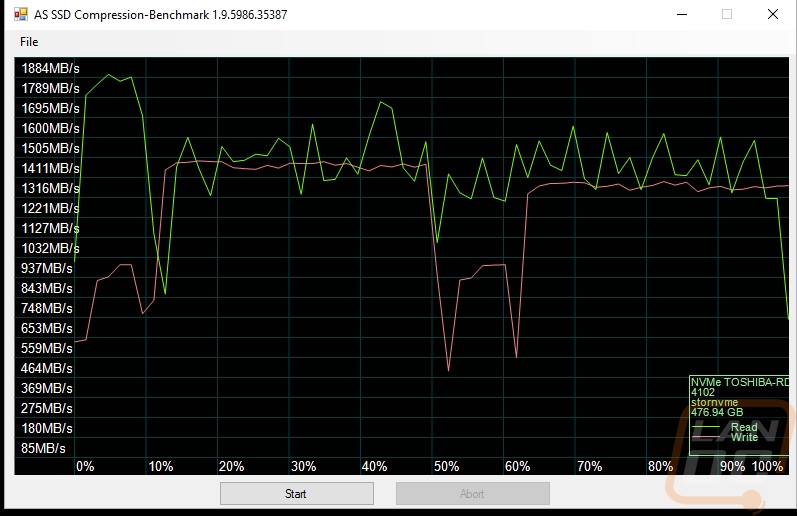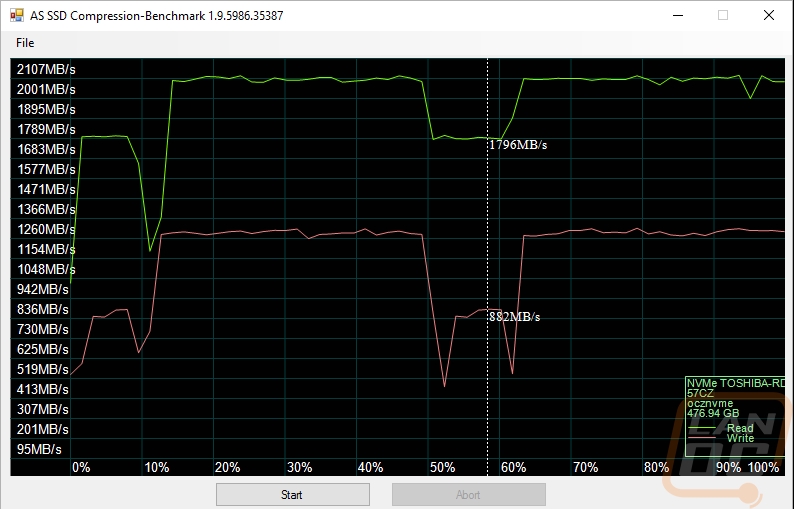Performance
Installing the RD400 is going to depend on your PC configuration but there are a few things to keep in mind. For starters, if you are planning on using it in an M.2 port on your motherboard, make sure it supports the length of the drive (2280). You also want to make sure your motherboard supports PCIe drives over M.2 and hopefully you also have PCIe x4 bandwidth on the port for full performance. If any of those are an issue or if you don’t have an M.2 port you will need to use the PCIe adapter included with the drive. Again you need an x4 or higher PCIe slot for full performance.
If you are using the RD400 as a secondary drive you don’t need to worry about support, but if you plan on using it as a boot drive you need to confirm that your motherboard supports NVMe at all. A lot of the older motherboards have added support in BIOS updates, but without it you won’t be able to boot from the drive. I ran into this on my own PC last year even. New chipsets all support it though so if you are building new you are good to go.
Last but not least you need to make sure you install the driver. Initially, I assumed the RD400 ran off the same NVMe driver from Intel that most drives use but as you will see in the two graphs below that wasn’t the case. In the first graph, not only was performance lower than it should be but the performance was erratic. Installing OCZs drive fixed this. I just wanted to make sure to point out how important it Is to have the correct driver installed, even if you test things every day and think you know the answer but end up being wrong.

Without custom driver

With custom driver
After I got the OCX RD400 installed and actually had the correct driver I was finally able to start my testing. Actually, I had tested with the bad driver, so really I redid my testing. But let’s jump into the results. My first tests were using CrystalDiskMark and frankly, I was blown away right out of the hole by the read performance of the RD400. The Intel 750 Series is an amazingly fast drive and the RD400 outperformed it by a full 1000MB/s in this test. The write results weren’t as impressive in comparison but the RD400 outperformed in that test as well.


Next, I tested using AS SSD’s file transfer benchmarks. These tests test transferring different types of files like an ISO, a program, or a game and the end result is the amount of time it took. In this case, the lowest result is the fastest. Because none of the results individually have special meaning, I combine all of the results so we can better see how each drive handled all three tests together. In this test, the RD400 didn’t perform as well with the Intel 750 Series pulling back ahead. The RD400 did perform really well compared to the Predator from HyperX that is a more direct competitor, though. The Patriot drive in these results is an M.2 but is SATA based and gives us a good look at the significant difference between a PCIe and SATA based M.2 drive.

In Passmark I dig into the advanced tools and I test using the disk benchmark tool. To keep things easy for everyone to duplicate my results on their own drives I used the four standard settings that Passmark has provided. Each of the tests has been designed to synthetically replicate a specific business usage environment. In this test, the OCZ RD400 dwarfs the results of the Predator but the Intel just goes crazy in the web server and file server results, changing the entire scale of the graph. The RD400 out performance everything else in the Workstation test and this is the one most likely to replicate a normal everyday usage that most of us would see. The Database numbers between the RD400 and the 750 Series are also close with an edge towards the Intel drive.

Next to get a look at a more real world benchmark I test using PCMark 8’s Storage benchmark. This test runs through a series of everyday tasks and retests three times for consistency. I don’t like the scores that PCMark provides because they don’t really do a good job of showing the differences between drives but the overall storage bandwidth result does. It shows us the average speed over all of the testing. In this test, the RD400 slightly outperformed the 750 Series and was WAY ahead of the Predator.

Next, I wanted to take a look at overall IOPS performance. Here I used Anvil’s Storage Utility and I focus on the 4k QD16 results on both the read and write tests. Because some drives perform better on one or the other I do stack the results together to see the combined performance but frankly, the Intel and the Rd400 are in a world of their own here. For the read results the RD400 is a little faster but the Intel 750 Series just runs away with the write performance numbers. What is most interesting to me though is that the RD400’s read and write numbers are almost the same, the drive is well balanced.

For my test tests, I stay in Anvil’s Storage Utility, but I go through and individually test the OCZ RD400 at a wide variety of queue depths both in read performance and write performance. Here we can see just how the 4 channel controller handles more and more load being thrown at it. Here the RD400 performs on par with the Intel 750 Series drive in the read speed benchmarks up until it hits a queue depth of 32 where it runs right into a wall. The 750 Series with its 18 channel design doesn’t have this issue and continues to perform better as the queue depths get up to 128. In the write benchmarks, the Intel is well ahead right from the start where the RD400 performs on par with the other drives early on and only really outperforms those drives when the queue depth gets up to 4. Does well up until the last test where it actually performs slower than the Predator due to a big drop in performance at that queue depth. What do we learn from these two sets of benchmarks? Well, the Intel 750 Series is still in a world of its own for one. But the RD400 performs better than other similar drives but be careful with overloading it on the writes.




